Farmland Zoning Integrating Agricultural Multi-Functional Supply, Demand and Relationships: A Case Study of the Hangzhou Metropolitan Area, China
Abstract
:1. Introduction
2. Materials and Methods
2.1. Study Area
2.2. Data Sources
2.3. Methods
2.3.1. Supply and Demand Evaluation of Farmland’s Functions
- 1.
- Supply evaluation
- Production supply: Comprehensively considering the current benefits and future potential, two factors, i.e., the actual output and production potential, were together used to characterize the production supply of farmland in this study. The production potential was characterized by the classification and grading data for agricultural land. The calculation formula for the production supply capacity is as follows:where is the production supply index in grid cell i; is the production potential value in grid cell i of region j; is the total value of the production potential within region j; is the total actual output of the farmland within region j.
- Ecological supply: According to the actual circumstances of the study area and prior related studies [11,15,17,22], we used four sub-functions, i.e., soil retention, habitat maintenance, landscape connectivity and environmental functions, to characterize the spatial heterogeneity of the ecological supply of farmland. Soil retention was defined as the capacity of farmland for reducing surface-soil erosion, maintaining soil nutrients and controlling sediment runoff compared with bare land [22]. The classic revised universal soil loss equation (RUSLE) was used to evaluate it in this study [23]. Habitat maintenance refers to the potential of farmland to provide species with suitable habitats for survival, reproduction and sustainable development [15]; we used the InVEST model to simulate it. Landscape connectivity reflects the degree of connection between farmland plots and their surrounding landscape plots [24]. Considering that the circuit theory model has greater randomness in the process of simulating species migration [25], we used it to map the landscape connectivity of the farmland in the study area. Environmental functions were assessed by three metrics, i.e., fertilizer, pesticide and plastic film consumption per unit of farmland [11]. A detailed description of the calculation of these functions is attached in Appendix A.
- Landscape-cultural supply: The Maxent software (version 3.4.1) was used to map the landscape-cultural supply (aesthetics and recreation) of the farmland within the study area. Two sets of data, i.e., the occurrence localities of given observation points and environmental variables, were needed as input for the Maxent model. The former was represented by the location information of typical farmland randomly selected from the most popular tourism routes for agritourism published online by the government in April 2018 [26]. It included 100 aesthetic and recreational farmland samples. The latter consisted of ten natural and human variables selected based on their relationships with landscape-cultural supply. Details of the calculation process for this function have been introduced in a previous study by the author [6].
- 2.
- Demand evaluation
- Production demand: Crop consumption data, obtained from statistical yearbooks or national economic statistical bulletins, can directly reflect the residents’ demand for the production function of farmland. However, due to its county-level scale, it is difficult for it to reflect more detailed spatial demand information. Thus, this study used the gross domestic product (GDP) data at a resolution of 1 km as a substitute indicator. We assumed that residents in regions with strong economies also had higher requirements for the quality of food consumed, which can indirectly reflect their higher demand for farmland production.
- Ecological demand: Considering that forests, gardens and other areas with significant vegetation coverage are outstanding in the supply of ecological effects [29], this study assumed that the lower the proportion of green land around farmland, the higher would be the demand for ecological farmland. Therefore, the green land (gardens and forests) ratio (GLR) within 1 km around the farmland calculated using the zonal statistics tool in ArcGIS was used to represent the ecological demand of residents for farmland functions in this study.
- Landscape-cultural demand: Considering that proximity is decisive for the experience of the aesthetics of and recreation in farmland landscape, we characterized the landscape-cultural demand of farmland according to the distribution of the beneficiaries [6]. In addition to the residents characterized by PD, the tourists of agritourism (TA) were another indicator used to evaluate the demand for cultural landscapes from farmland in this research. The TA data were acquired from the Hangzhou Statistical Yearbooks, and they covered the population information of each administrative unit in the study area. We then converted them to a shape file using ArcGIS 10.2.
2.3.2. Evaluation of Relationships between Functions
2.3.3. Farmland-Use Zoning
3. Results
3.1. Patterns of Supply Capacity
3.2. Patterns of Demand Level
3.3. Relationships between Multiple Functions of Farmland
3.4. Farmland Zoning Based on the Characteristics of Matching between Supply and Demand, and the Relationships between Multiple Functions
4. Discussion
4.1. Evaluation of Supply and Demand Patterns of Farmland
4.2. Relationships between Multiple Functions of Farmland
4.3. Comprehensively Considering Supply, Demand and Relationships of Multiple Functions in Farmland Zoning Is Important for Realizing Reasonable Usage of Farmland Resources
- The farmland within Z1 is veritable urban farmland. It is mainly distributed along traffic lines and around towns, and is close to many tourist attractions, so its landscape and cultural functions are very prominent [6]. The medium value of MCCD indicates a certain potential for the multi-functional compound development of these farmland. Furthermore, the high population density and urbanization level make its multi-functional demand generally high. Therefore, more attention should be devoted to the ecological and production supply in these farmland to meet high demand while simultaneously improving the landscape-cultural functions. Contrary to that of Z1, farmland within Z6 was characterized by low MCCDs. Due to the high altitude and inconvenient traffic situation, its productive and cultural capacities are poor [11]. It is recommended to focus on solving the low contiguousness of this farmland through land consolidation and ecological restoration, and to improve its deree of utilization by constructing infrastructures.
- The farmland within Z2 and Z3 is all located in suburban areas. The geographical advantages of being located in a plain water network and close to downtown areas make this farmland characterized by relatively high multi-functional demand, as well as high production and landscape-cultural supply capacity [11,12]. However, contrary to that of Z2, the farmland within Z3 has lower MCCDs. This farmland is mainly responsible for supplying vegetables and aquatic products to urban areas and thus need large amounts of chemical fertilizers, pesticides and films. Additionally, many industrial areas are concentrated here. The low ecological benefits caused by these factors may have hindered the MCCDs of this farmland. Strengthening the control and supervision of soil pollution may present an opportunity to ensure the sustainable usage and development of these farmland resources.
- Z4 and Z5 are rural farmland. Z4 is a densely occupied by high-quality farmland. Benefiting from its good site condition, superior natural environment and long historical farming culture, the production, ecological and landscape-cultural functions of this farmland have all developed synergistically. However, fragmented landscapes and inconvenient transportation hinder the synergy between the productive and aesthetic functions of farmland in Z5. Thus, promoting specialty agricultural products, such as mountain vegetables and fruits, and creating exclusive agricultural brands in the countryside may be the opportunity to maximize the multi-functional compound benefits of these farmland [42].
5. Conclusions
Author Contributions
Funding
Institutional Review Board Statement
Informed Consent Statement
Data Availability Statement
Conflicts of Interest
Appendix A
Appendix A.1. Soil Retention

Appendix A.2. Habitat Maintenance
| Threat Sources | Maximum Influence Distance (km) | Weights | Declining Linear Correlation |
|---|---|---|---|
| Urban land | 16 | 0.9 | exponential |
| Rural settlement | 12 | 0.8 | exponential |
| Traffic land | 20 | 1 | linear |
| Other construction land | 8 | 0.5 | exponential |
| Farmland Types | Habitat Suitability | Urban Land | Rural Settlement | Traffic Land | Other |
|---|---|---|---|---|---|
| Plain paddy field | 0.8 | 0.6 | 0.5 | 0.3 | 0.25 |
| Plain dry land | 0.7 | 0.5 | 0.4 | 0.2 | 0.15 |
| Slope paddy field | 0.9 | 0.8 | 0.6 | 0.5 | 0.35 |
| Slope dry land | 1 | 0.9 | 0.7 | 0.5 | 0.4 |
| Non-arable land | 0 | 0 | 0 | 0 | 0 |
Appendix A.3. Landscape Connectivity
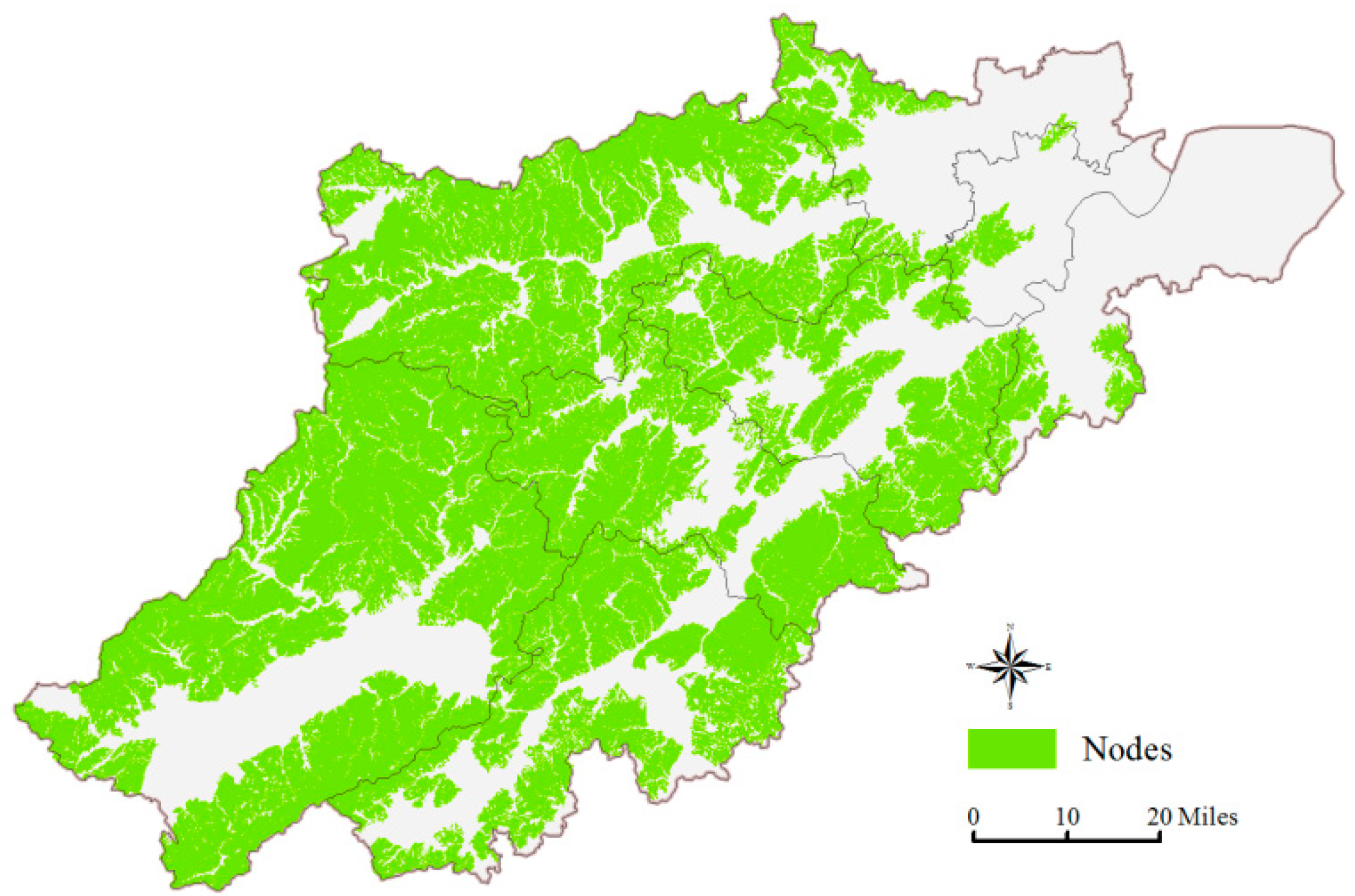
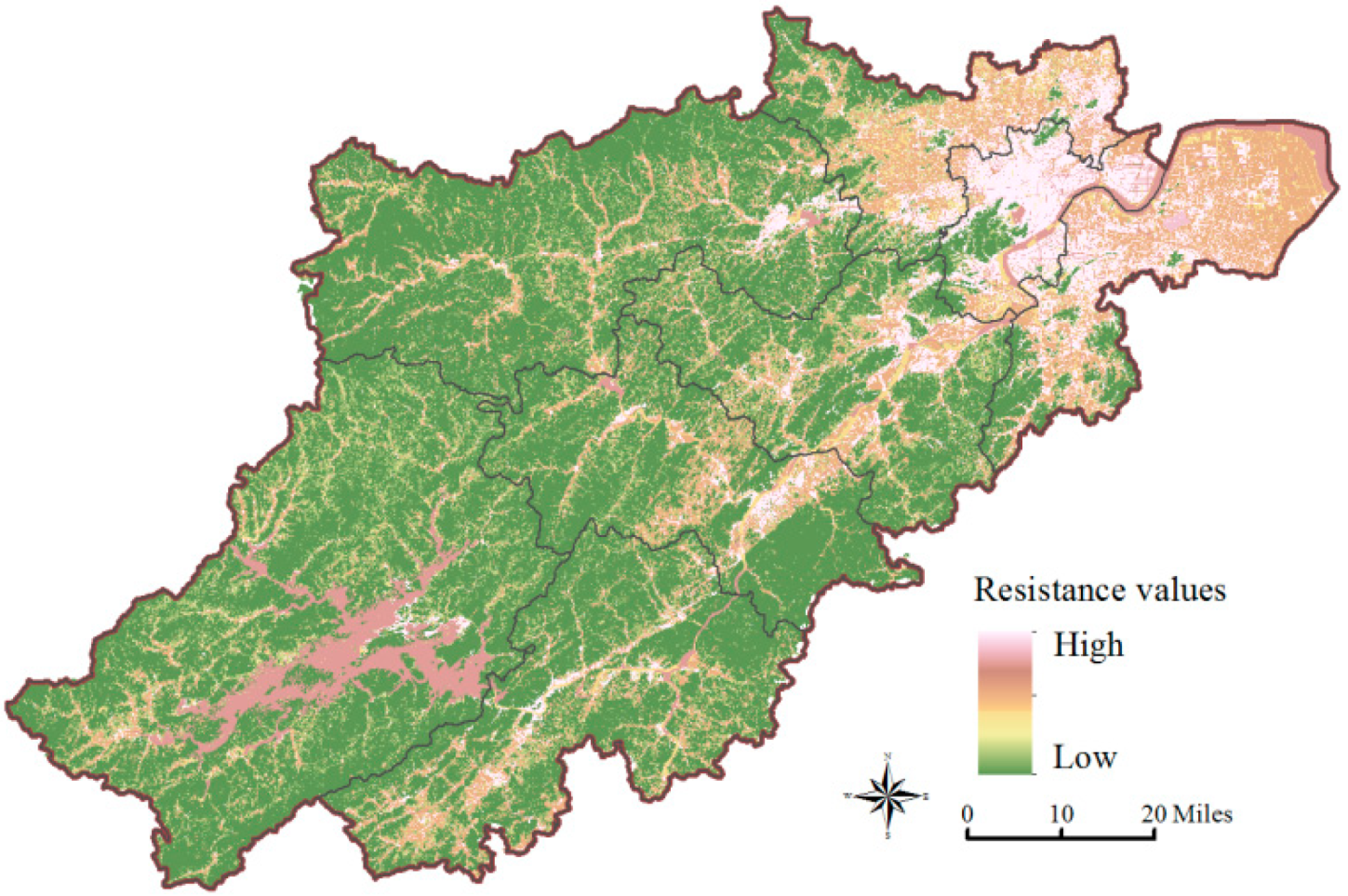
Appendix A.4. Environmental Factors
References
- Cheng, L.; Jiang, P.; Chen, W.; Li, M.; Wang, L.; Gong, Y.; Pian, Y.; Xia, N.; Duan, Y.; Huang, Q. Farmland protection policies and rapid urbanization in China: A case study for Changzhou City. Land Use Policy 2015, 48, 552–566. [Google Scholar]
- Lu, X.; Huang, S. Barriers of and solutions to farmland conservation in China. J. Huazhong Univ. Sci. Technol. 2010, 24, 79–84. [Google Scholar]
- Luo, X.; Luo, J.; Zhang, L. Farmland pressure and China’s urbanisation: An empirical study with the view of geographical difference. Chin. J. Popul. Sci. 2015, 127, 47–59. [Google Scholar]
- Su, Y.; He, S.; Wang, K.; Shahtahmassebi, A.R.; Zhang, L.; Zhang, J.; Zhang, M.; Gan, M. Quantifying the sustainability of three types of agricultural production in China: An emergy analysis with the integration of environmental pollution. J. Clean. Prod. 2020, 252, 119650. [Google Scholar] [CrossRef]
- Si, Z.; Li, M.; Qiu, W.; Yun, W. Regional difference analysis and preservation of cultivated land resources in China. J. Nat. Resour. 2010, 25, 713. [Google Scholar]
- He, S.; Su, Y.; Shahtahmassebi, A.R.; Huang, L.; Zhou, M.; Gan, M.; Deng, J.; Zhao, G.; Wang, K. Assessing and mapping cultural ecosystem services supply, demand and flow of farmlands in the Hangzhou metropolitan area, China. Sci. Total Environ. 2019, 692, 756–768. [Google Scholar] [CrossRef]
- Xu, K.; Wang, J.; Wang, J.; Wang, X.; Chi, Y.; Zhang, X. Environmental function zoning for spatially differentiated environmental policies in China. J. Environ. Manag. 2020, 255, 109485. [Google Scholar] [CrossRef]
- Fischer, S.; Thatje, S. Temperature effects on life-history traits cause challenges to the management of brachyuran crab fisheries in the Humboldt Current: A review. Fish. Res. 2016, 183, 461–468. [Google Scholar] [CrossRef]
- CzyEwski, B.; Matuszczak, A. A new land rent theory for sustainable agriculture. Land Use Policy 2016, 55, 222–229. [Google Scholar] [CrossRef]
- Jin, G.; Deng, X.; Zhang, Q.; Wang, Z.; Li, Z. Comprehensive function zoning of national land space for Wuhan metropolitan region. Geogr. Res. 2017, 36, 541–552. [Google Scholar]
- Fan, Y.; Jin, X.; Xiang, X.; Yang, X.; Liu, J.; Zhou, Y. Evaluation and spatial characteristics of arable land multifunction in southern Jiangsu. Resour. Sci. 2018, 40, 980–992. [Google Scholar]
- Fang, Y.; Wang, J.; Kong, X.; Rongtao, W.U.; Baolian, L.I.; Liu, J. Trade-off relation measurement and zoning optimization of multi-functionality of cultivated land use: A case study of Henan Province. China Land Sci. 2018, 32, 57–64. [Google Scholar]
- Yang, L.; Yi, Z.; Lin, B.; Xu, W.; Wang, C. Analysis for the characteristics of spatial difference of cultivated land quality in Fujian Province. Chin. J. Agric. Resour. Reg. Plan. 2018, 39, 52–58. [Google Scholar]
- Jain, A.K. Data clustering: 50 years beyond K-means. Pattern Recognit. Lett. 2010, 31, 651–666. [Google Scholar] [CrossRef]
- Peng, J.; Liu, Z.; Liu, Y.; Chen, X.; Zhao, H. Assessment of farmland landscape multifunctionality at county level in BeijingTianjin-Hebei area. Acta Ecol. Sin. 2016, 36, 2274–2285. [Google Scholar]
- Power, A.G. Ecosystem services and agriculture: Tradeoffs and synergies. Philos. Trans. R. Soc. B Biol. Sci. 2010, 365, 2959–2971. [Google Scholar] [CrossRef]
- Zhu, Q.; Hu, W.; Zhao, Z. Dynamic analysis on spatial-temporal pattern of trade-offs and synergies of multifunctional cultivated land—Evidence from Hubei Province. Econ. Geogr. 2018, 38, 143–153. [Google Scholar]
- Ren, S.; Hu, Y.; Liu, Z.; Xin, Z. Study on the supply and demand of cultivated land eological service function in metropolitan area. Guangdong Land Sci. 2019, 18, 14–22. [Google Scholar]
- Fei, D.; Cheng, Q.; Mao, X.; Liu, F.; Zhou, Q. Land use zoning using a coupled gridding- self-organizing feature maps method: A Case Study in China. J. Clean. Prod. 2017, 161, 1162–1170. [Google Scholar] [CrossRef]
- Hu, W.Y.; Wei, A.Q.; Zhao, Z.S.; Zhang, A.L.; Song, Y. Literature review on mismatch of demand and supply, and syner-gies of multifunctional agricultural land. China Land Sci. 2017, 31, 90–96. [Google Scholar]
- Bureau, H.S. Hangzhou Statistical Yearbook; China Statistical Press: Beijing, China, 2018. [Google Scholar]
- Wang, C.; Li, X.; Yu, H.; Wang, Y. Tracing the spatial variation and value change of ecosystem services in Yellow River Delta, China. Ecol. Indic. 2019, 96, 270–277. [Google Scholar] [CrossRef]
- Renard, K.G.; Foster, G.R.; Weesies, G.A.; Mccool, D.K.; Yoder, D.C. Predicting Soil Erosion by Water: A Guide to Conservation Planning with the Revised Universal Soil Loss Equation (RUSLE); United States Government Printing: Washington, DC, USA, 1997.
- Yang, Z.; Xu, J.; Feng, X.; Guo, M.; Jin, Y.; Gao, X. Effects of land use change on habitat based on InVEST model in Northeast China. Ecol. Sci. 2018, 37, 139–147. [Google Scholar]
- Mcrae, B.H.; Beier, P. Circuit theory predicts gene flow in plant and animal populations. Proc. Natl. Acad. Sci. USA 2007, 104, 19885–19890. [Google Scholar] [CrossRef] [Green Version]
- The 100 Recommended Routes of Leisure Agriculture and Rural Tourism in Zhejiang Province. Available online: http://www.zjagri.gov.cn/jpxl/html/index.html (accessed on 19 March 2020).
- Wolff, S.; Verburg, P.H.; Schulp, C.J.E. Mapping ecosystem services demand: A review of current research and future perspectives. Ecol. Indic. 2015, 55, 159–171. [Google Scholar] [CrossRef]
- Yoshimura, N.; Hiura, T. Demand and supply of cultural ecosystem services: Use of geotagged photos to map the aesthetic value of landscapes in Hokkaido. Ecosyst. Serv. 2017, 24, 68–78. [Google Scholar] [CrossRef]
- Xie, G.; Zhen, L.; Lu, C.; Xiao, Y.; Chen, C. Expert knowledge based valuation method of ecosystem services in China. J. Nat. Resour. 2008, 23, 911–919. [Google Scholar]
- Spearman, C. The proof and measurement of association between two things. Am. J. Psychol. 1904, 15, 72–101. [Google Scholar] [CrossRef]
- Liu, H.; Zhang, Y.; Zheng, W. Evaluation on spatio-temporal development and interaction of intensive urban land use and urbanization: Case studies of the cities in the Bohai Rim Region. Geogr. Res. 2011, 30, 1805–1817. [Google Scholar]
- Li, F.; Guo, S.; Li, D.; Li, X.; Xie, S. A multi-criteria spatial approach for mapping urban ecosystem services demand. Ecol. Indic. 2020, 112, 106119. [Google Scholar] [CrossRef]
- Yda, B.; Lin, Z.; Xyb, C.; Mb, A.; Gjc, A.; Zx, C. Assessing the influences of ecological restoration on perceptions of cultural ecosystem services by residents of agricultural landscapes of western China—ScienceDirect. Sci. Total Environ. 2019, 646, 685–695. [Google Scholar]
- Cheng, L.; Xia, N.; Jiang, P.; Zhong, L.; Pian, Y.; Duan, Y.; Huang, Q.; Li, M. Analysis of farmland fragmentation in China Modernization Demonstration Zone since “Reform and Openness”: A case study of South Jiangsu Province. Sci. Rep. 2015, 5, 11797. [Google Scholar] [CrossRef] [PubMed] [Green Version]
- Clemente, P.; Calvache, M.; Antunes, P.; Santos, R.; Cerdeira, J.O.; Martins, M.J. Combining social media photographs and species distribution models to map cultural ecosystem services: The case of a Natural Park in Portugal. Ecol. Indic. 2019, 96, 59–68. [Google Scholar] [CrossRef]
- Gao, J.; Barbieri, C.; Valdivia, C. Agricultural landscape preferences: Implications for agritourism development. J. Travel Res. 2014, 53, 366–379. [Google Scholar] [CrossRef] [Green Version]
- Ibnescu, B.C.; Stoleriu, O.M.; Munteanu, A.; Iatu, C. The impact of tourism on sustainable development of rural areas: Evidence from romania. Sustainability 2018, 10, 3529. [Google Scholar] [CrossRef] [Green Version]
- Sroka, W.; Mikolajczyk, J.; Wojewodzic, T.; Kwoczynska, B. Agricultural land vs. urbanisation in chosen Polish metropolitan areas: A spatial analysis based on regression trees. Sustainability 2018, 10, 837. [Google Scholar] [CrossRef] [Green Version]
- Sarah, T.L. Multifunctional urban agriculture for sustainable land use planning in the United States. Sustainability 2010, 2, 2499–2522. [Google Scholar]
- Yoshida, S.; Yagi, H.; Kiminami, A.; Garrod, G. Farm diversification and sustainability of multifunctional peri-urban agriculture: Entrepreneurial attributes of advanced diversification in Japan. Sustainability 2019, 11, 2887. [Google Scholar] [CrossRef] [Green Version]
- Guo, H. The significance situation and prospects of the development of leisure agriculture in China. Chin. J. Agric. Resour. Reg. Plan. 2010, 31, 39–42. [Google Scholar]
- Minta, S.; Tańska-Hus, B.; Nowak, M. The implementation of concept of a regional product “sudeten beef” in the context of environment protection. Rocz. Ochr. Srodowiska 2013, 15, 2887–2898. [Google Scholar]
- Wischmeier, W.H. Predicting Rainfall Erosion Losses—A Guide to Conservation Planning; Science and Education Administration: Washington, DC, USA, 1978; p. 537. [Google Scholar]
- Wang, W.; Jiao, J.; Hao, X.; Zhang, X.; Lu, X.; Chen, F.; Wu, S. Distribution of Rainfall Erosivity R Value in China. J. Soil. Water. Conserv. 1996, 2, 29–39. [Google Scholar]
- Zhou, F.; Huang, Y. The rainfall erosivity index in Fujian province. J. Soil Water Conserv. 1995, 9, 13–18. [Google Scholar]
- Williams, J.R.; Jones, C.A.; Dyke, P.T. A modeling approach to determining the relationship between erosion and soil productivity. Trans. ASAE 1984, 27, 129–144. [Google Scholar] [CrossRef]
- Zhou, M.; Deng, J.; Lin, Y.; Belete, M.; Wang, K.; Comber, A.; Huang, L.; Gan, M. Identifying the effects of land use change on sediment export: Integrating sediment source and sediment delivery in the Qiantang River Basin, China. Sci. Total Environ. 2019, 686, 38–49. [Google Scholar] [CrossRef] [PubMed]
- Liu, B.; Liu, S.; Zheng, S. Soil conservation and coefficient of soil conservation of crops. Res. Soil Water Conserv. 1999, 6, 32–36. [Google Scholar]
- Teng, H. Assimilating Multi-Source Data to Model and Map Potential Soil Loss in China. Ph.D. Thesis, Zhejiang University, Hangzhou, China, 2017. [Google Scholar]
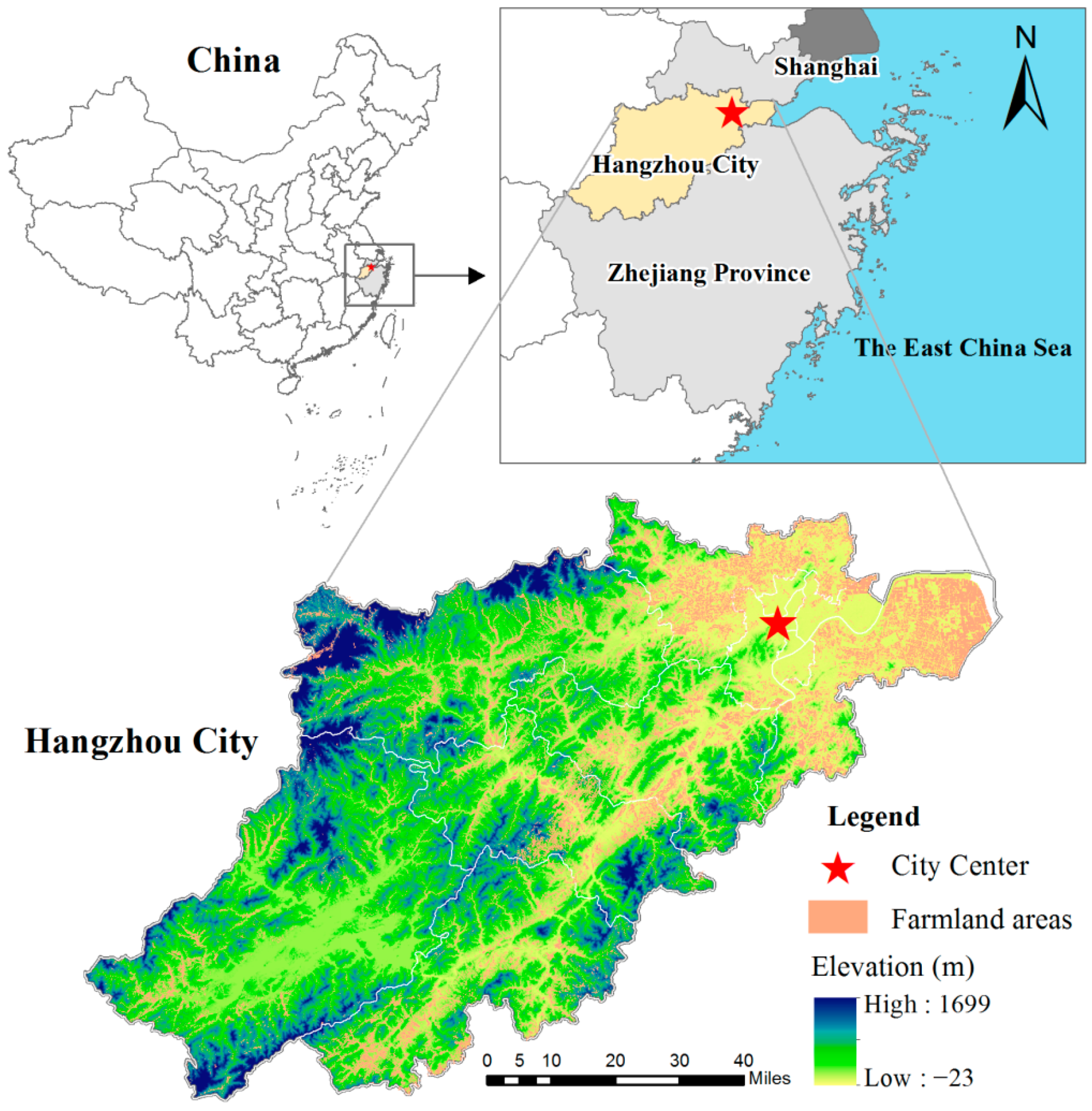


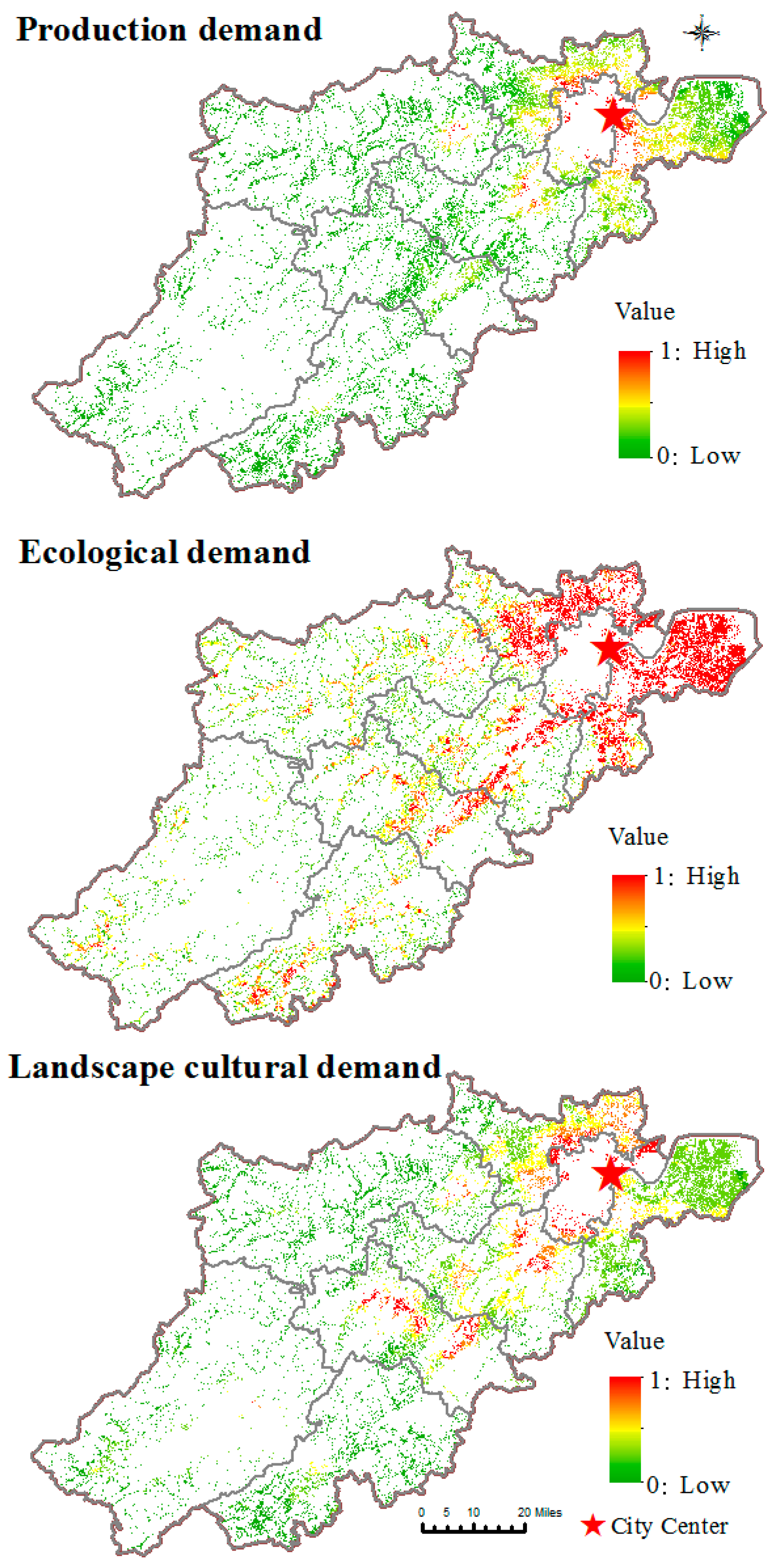
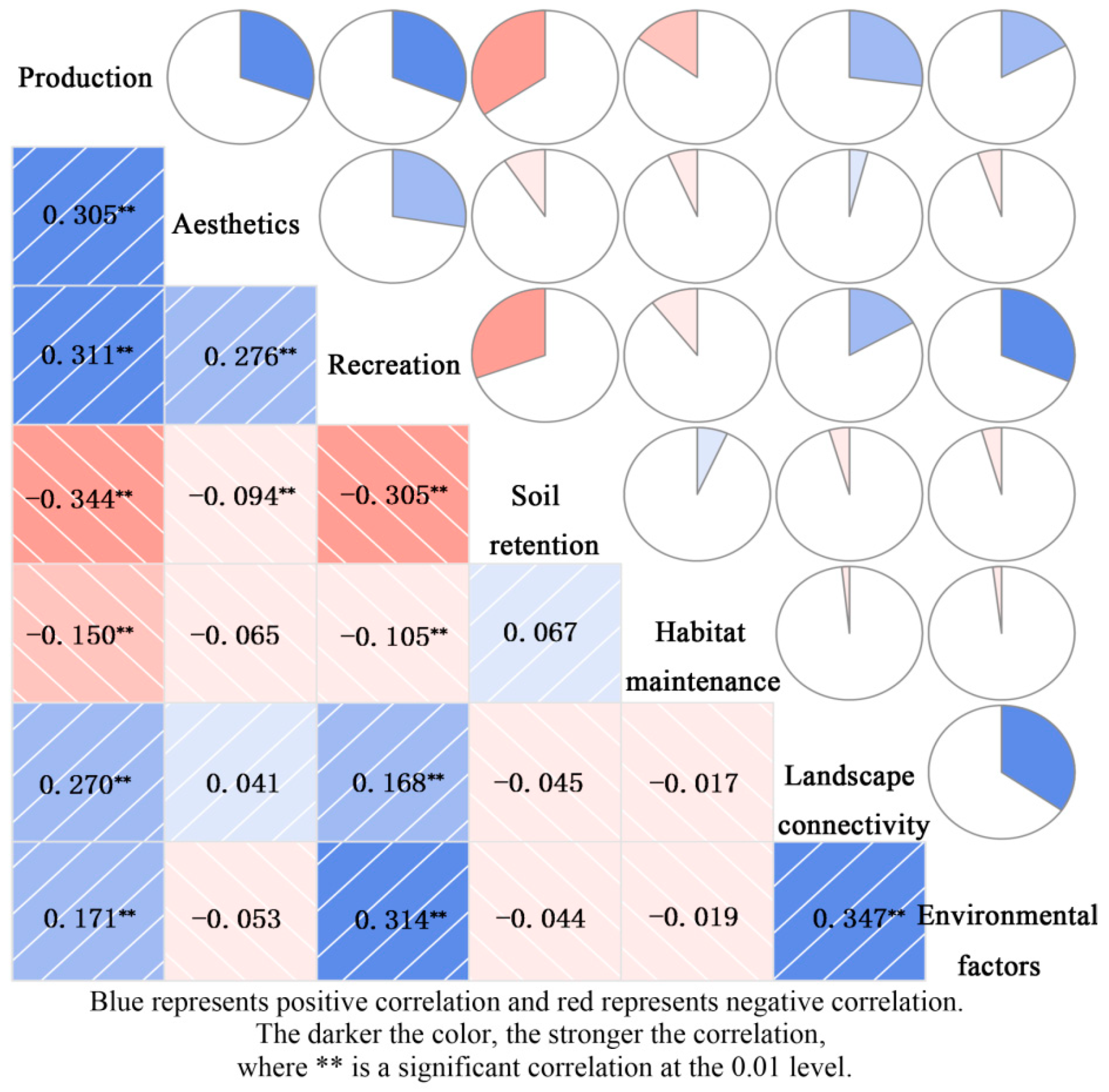

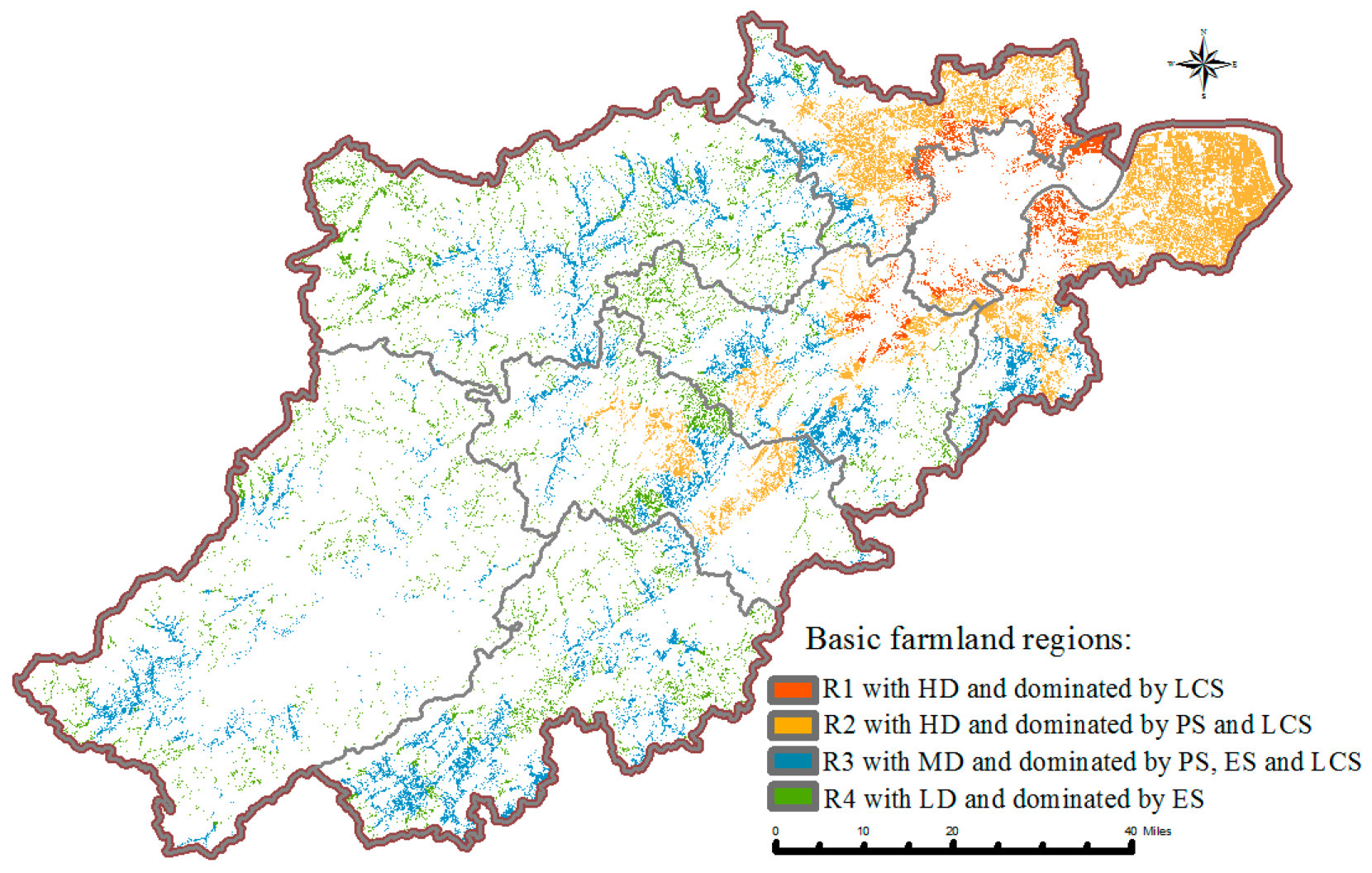
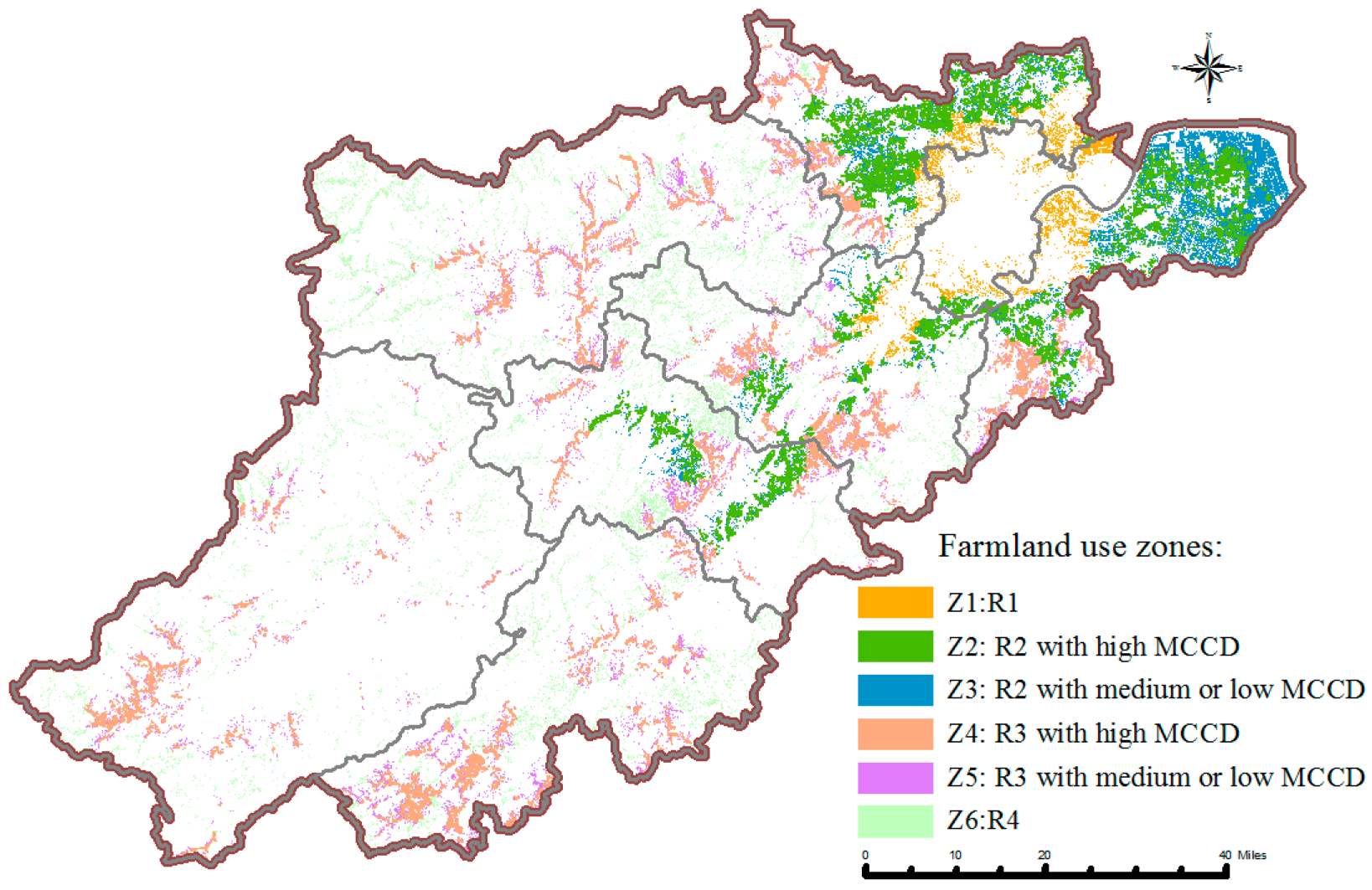
| Data | Type | Resolution | Source |
|---|---|---|---|
| Classification and grading data for agricultural land; Land-use survey data | Shape file | 1:10,000 | Land and Resources Bureau of Hangzhou |
| Actual output of crops; fertilizer, pesticide and plastic film consumption data; agritourists | Geo Tiff | County | Hangzhou Statistical Yearbooks (http://www.hangzhou.gov.cn, accessed on 26 September 2021) |
| Residents | Geo Tiff | 100 m | WorldPop project (https://www.worldpop.org/, accessed on 26 September 2021) |
| Digital elevation model; NDVI | Geo Tiff | 30 m | Geospatial data cloud (http://www.gscloud.cn, accessed on 26 September 2021) |
| Typical farmland | Shape file | 100 points | The most popular tourism routes (http://nynct.zj.gov.cn, accessed on26 September 2021) |
| GDP | Geo Tiff | 100 m | Geographical Information Monitoring Cloud Platform (http://www.dsac.cn/, accessed on 26 September 2021) |
| Soil data | Geo Tiff | 1:200,000 | Map of the Second National Soil Survey |
| Meteorological data | Geo Tiff | 1000 m | World Weather Database (1950–2010) (https://worldclim.org/, accessed on 26 September 2021) |
Publisher’s Note: MDPI stays neutral with regard to jurisdictional claims in published maps and institutional affiliations. |
© 2021 by the authors. Licensee MDPI, Basel, Switzerland. This article is an open access article distributed under the terms and conditions of the Creative Commons Attribution (CC BY) license (https://creativecommons.org/licenses/by/4.0/).
Share and Cite
He, S.; Lin, L.; Xu, Q.; Hu, C.; Zhou, M.; Liu, J.; Li, Y.; Wang, K. Farmland Zoning Integrating Agricultural Multi-Functional Supply, Demand and Relationships: A Case Study of the Hangzhou Metropolitan Area, China. Land 2021, 10, 1014. https://doi.org/10.3390/land10101014
He S, Lin L, Xu Q, Hu C, Zhou M, Liu J, Li Y, Wang K. Farmland Zoning Integrating Agricultural Multi-Functional Supply, Demand and Relationships: A Case Study of the Hangzhou Metropolitan Area, China. Land. 2021; 10(10):1014. https://doi.org/10.3390/land10101014
Chicago/Turabian StyleHe, Shan, Lin Lin, Qian Xu, Chenxia Hu, Mengmeng Zhou, Jinhua Liu, Yongjun Li, and Ke Wang. 2021. "Farmland Zoning Integrating Agricultural Multi-Functional Supply, Demand and Relationships: A Case Study of the Hangzhou Metropolitan Area, China" Land 10, no. 10: 1014. https://doi.org/10.3390/land10101014






